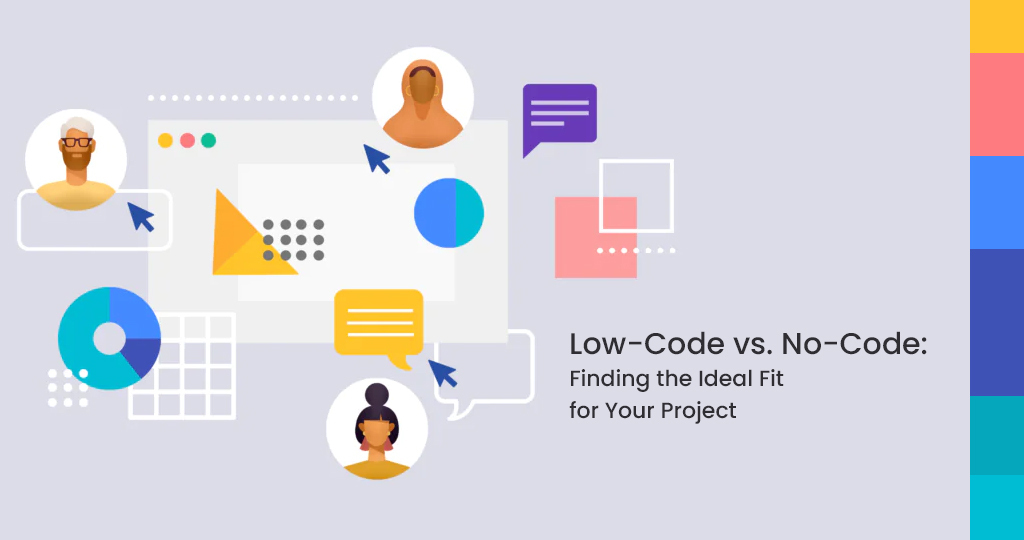In software development, the emergence of low-code and no-code platforms has changed the way applications are built. These platforms promise to democratize development by enabling individuals with varying technical backgrounds to create powerful software solutions. However, choosing between low-code and no-code is a critical decision that depends on the complexity of the project, the skill set of the team, and the long-term goals of the organization.
Key Takeaways
Low-code suits intricate projects with extensive customization needs. No-code excels in simpler applications and rapid prototyping.
Low-code is for proficient coders, offering customization through coding. No-code is user-friendly, empowering non-technical users and business contributors.
No-code accelerates development, ideal for projects with tight deadlines. Low-code balances speed and flexibility, suitable for various project timelines.
Low-code offers depth and flexibility for intricate customization. No-code prioritizes simplicity, catering to users with varied technical backgrounds.
No-code incurs lower upfront costs, ideal for smaller projects. Low-code might demand a higher initial investment but offers long-term cost benefits for larger projects.
What is Low-Code Development?
Low-code platforms provide a middle ground between traditional coding and visual development. They typically involve a drag-and-drop interface with pre-built components and require a minimal amount of coding for customization. Low-code platforms are ideal for projects that demand a higher level of customization and scalability, catering to developers with moderate coding skills.
What is No-Code Development?
No-code platforms take simplicity a step further by allowing users to create applications without any coding at all. These platforms utilize visual development interfaces, enabling users to assemble applications through pre-built components and automation. No-code solutions are best suited for simple applications, prototypes, or workflow automation, making them accessible to users with little to no coding experience.
Difference Between Low-Code and No-Code Platform
Low-code and no-code platforms represent distinct approaches in software development. Low-code platforms provide a middle ground between traditional coding and visual development, featuring a drag-and-drop interface and pre-built components. These platforms require a minimal amount of coding, making them suitable for projects demanding customization and scalability, catering to developers with moderate coding skills.
On the other hand, no-code platforms take simplicity to the next level, enabling users to create applications without any coding. Leveraging visual development interfaces and automation, no-code solutions are geared towards simplicity, making them accessible to users with little to no coding experience, focusing on rapid prototyping and workflow automation for simpler applications.
Factors to Assess when Choosing the Right Platform
1. Project Complexity The complexity of your project is a crucial factor in deciding between low-code and no-code platforms. Low-code solutions are better equipped to handle intricate projects that demand more customization and flexibility. No-code platforms, on the other hand, are ideal for simpler projects or rapid prototyping where speed is paramount.
2. Team Skillset Assessing the skill set of your development team is essential. If your team consists of proficient coders, a low-code platform may be the right choice as it allows for more extensive customization through coding. Conversely, if your team lacks extensive coding expertise or includes business users, a no-code platform can empower them to contribute to the development process.
3. Time-to-Market The speed at which you need to deliver your application to the market is an important consideration. No-code platforms excel in reducing development time, making them suitable for projects with tight deadlines. Low-code platforms may take longer due to the additional customization options, but they offer a balance between speed and flexibility.
4. Scalability Consider the scalability requirements of your project. Low-code platforms are designed for scalability and can handle more complex projects that may grow over time. No-code platforms, while efficient for simpler projects, may face limitations when scalability becomes a significant concern.
Comparative Analysis
1. Customization and Flexibility Low-code platforms empower developers with customization capabilities through coding, facilitating the customization of applications to precise specifications. In contrast, no-code platforms, while adaptable within predefined boundaries, may fall short of delivering the intricate customization often essential for complex projects.
When confronted with the need for meticulous customization, particularly in intricate projects, opting for a low-code approach proves to be the superior choice. The depth and flexibility inherent in low-code platforms make them the ideal solution for projects demanding a high level of customization and adaptability to specific requirements.
2. Learning Curve No-code platforms prioritize user-friendliness, catering to individuals with limited technical expertise. These platforms boast a notably lower learning curve, empowering business users to actively engage in the development process. Low-code platforms, although more user-friendly than traditional coding, necessitate a baseline of coding proficiency. This characteristic positions low-code solutions as more suitable for developers who possess a level of coding expertise.
The distinction lies in accessibility; no-code platforms prioritize inclusivity, allowing non-technical users to contribute, while low-code platforms strike a balance by offering enhanced flexibility to developers while maintaining a degree of simplicity in comparison to traditional coding practices.
3. Cost Considerations No-code platforms typically incur lower upfront costs, attributed to their simplicity and user-friendly nature. These platforms reduce the necessity for extensive training and development resources, rendering them cost-effective for smaller projects. On the other hand, low-code platforms might demand a higher initial investment, encompassing licensing and training expenses. However, they offer long-term cost benefits, especially for larger and more intricate projects.
The difference in cost considerations lies in the immediate affordability of no-code solutions for simpler projects versus the potential cost efficiency of low-code platforms in handling the scalability and complexity demands of larger initiatives over time.
4. Maintenance and Updates Low-code platforms generally demand less maintenance effort due to their reliance on standardized components. The inherent standardization streamlines routine maintenance tasks, ensuring smoother day-to-day operations. However, during major upgrades or significant changes, low-code platforms may need additional attention to maintain seamless functionality. In contrast, no-code platforms, with their higher level of standardization, simplify ongoing maintenance tasks.
They excel at handling routine updates within their predefined capabilities. Nevertheless, challenges may arise when faced with updates that surpass the predefined limits, potentially requiring more intricate solutions or workarounds. The choice between low-code and no-code should factor in these considerations, balancing the ease of maintenance against the potential challenges posed by updates and changes in the long run.
Conclusion
Choosing between low-code and no-code platforms ultimately depends on the unique requirements of your project, the skills of your team, and your long-term goals. Thoroughly evaluating the specific needs of your project and understanding the capabilities of your team will guide you toward the platform that aligns best with your development goals. Whether opting for the customization prowess of low-code or the simplicity of no-code, both platforms have the potential to revolutionize the way software is developed, making it more inclusive and efficient.
At Way2Smile Solutions, a leading software development company, we recognize the significance of making informed choices in our software development process. Our team at Way2Smile Solutions leverages both low-code and no-code platforms, ensuring that we provide customized solutions that align precisely with our clients' unique requirements. We pride ourselves on delivering top-notch software development services, striking the perfect balance between customization, speed, and scalability that helps our clients achieve success in their digital endeavors.







